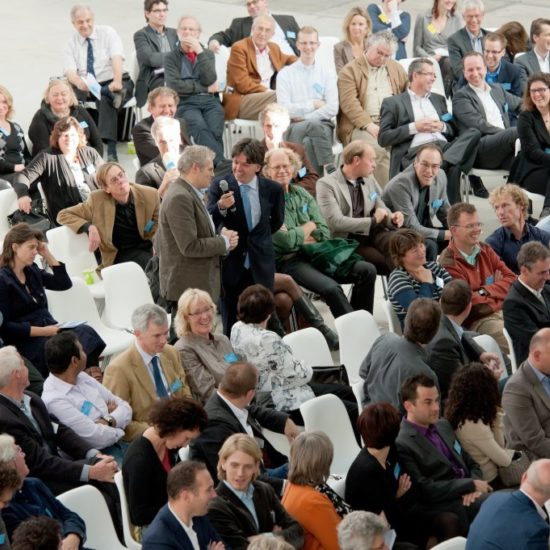In the picture, you see our Dutch queen Maxima, together with Ivanka Trump and Angela Merkel. It says everything about what goes wrong in panels and what should be changed.
Size of the panel
In our view, 3 people is the maximum for a succesfull panel … If they put a gun to your head, 4 is allowed. But if you take a close look, there’s at least a fifth person (apart from the moderator), just outside the picture on the left hand side. From experience we know, that this is too many and that with more then 4 the energy and interaction will go down. People will start fighting for their chance to say something, rather then listen and respond. And some will just give up, start staring into the audience and have a negative influence on energy in the room.
So if you need to have more then 4 in your panel, start looking for a concept to handle that problem: change the panel every few minutes, alternate the panel conversation with short 1-on-1 interviews, allow each panellist to have one private ‘commercial break’, etc.
Casting of the pannellists
A panel should be more then a random selection of speakers. And it should not be - like in most cases – a part of the programme, where you bring everyone on stage who has to be there for a number of (mostly political, tactical) reasons, but who have no real added value to the objective of the meeting.
In this case, conscious choices seem to have been made as to who to put on stage; which is a good thing. And they even seem to have different backgrounds: a politician, someone from corporate top-management, two second-ladies. This again is positive: a good panel features people who have a different opinion on the same problem, or who look at a challenge/question from a different perspective. This may be consumer-producer-government, management-workforce-union, or whatever works for that topic.
Typecasting
A great panel not only features conflicting or complementary views, it also makes opposite personalities meet. In this case all characters seem to be there: the thinker, the anarchist, the comedian, the big mouth. Having different kinds of people on stage should be one of the issues, when looking for panellists.
The moderator
Since we don’t know the moderator of this panel, we can’t tell you if she is professional and if she’s the right choice for this particular panel. What we cán see, is that her position is all wrong. First of all, in general we like to stand and walk around. This allows the moderator to take a different perspective on the panel every now and then, and makes interacting with the audience easier (by walking over to them).
But if you have to sit down for any number of reasons, do nót sit in the middle! The moderator should at all times be able to see all members of the panel in one glance, in order to observe how they respond to each other and to get interaction going. And that obviously is not the case, here: the moderator is looking at our queen Maxima and has no way of seeing what the rest of them are doing.
Interaction
Obviously (well, we think so … but most panels do show a different picture), you want the panel to interact with the audience. But in order to get that going, you first need to get the interaction within the panel going. And that is, where most panels fail.
In this case, we fear the same problem: looking at the body language, no one seems to be dying to respond to what queen Maxima is saying. They are either politely waiting for their turn to have their statement in, or even worse: they already did and are now waiting for this panel to be over.
Basically, if you do not get the panellists talking to each other, what is the use of putting them on stage as a group? If you want them speaking one after another, get them on stage one by one!
If you dó want them to interact, there’s a few tricks (apart from not sitting in the middle):
- Don’t ask all participants in the panel the same question. You take every answer to a next level immediately.
- Hop over to a next speaker, when ever you can: if you ask queen Maxima something, she answers. If the follow-up question could be answered by someone else just as well as by our queen, go to that other person.
- Observe: you will be able to tell, who has an opinion on what is said by one of her fellow-panellists. As soon as you see someone nod, ask that person why! If you do this at a somewhat higher pace early in the panel, people will get used to them having a real conversation and soon, all panellists will feel invited to join.
An ill-designed panel can kill; both participants and panellists. Well-executed on the other hand, the exchange of opinions, knowlegde and perspectives can be of tremendous added value.
Jan-Jaap


